To be completely honest, I expected Iguazu Falls to be at least slightly overrated. They just sounded too good to be true, especially considering the huge crowds that you would have to deal with.
But the reality is that Iguazu Falls is beyond epic. They are indescribable. Nowhere else can you feel such an awesomely unyielding force of nature in such a stunningly beautiful setting. Iguazu Falls are not just a sight; they are an experience.
There are many ways to experience Iguazu Falls. You can view them from two countries—Brazil and Argentina—at different times of the day and night, take a wild boat ride right under the falls’ veil, see them under the light of the full moon, or take a helicopter ride for a bird’ s-eye view.
We have spent two days exploring the falls as part of our Brazil nature and wildlife itinerary, and this post sums up all the research we’ve done prior to the trip, fact-checked by our own experience. But first, some facts about the falls.
READ MORE: 35 Amazing Brazilian Animals you Can Spot on your Travels
Iguazu Falls Facts
How much does it cost to go to Iguazu Falls?
Which side is the best side Iguazu Falls?
Brazil can lay claim to about 20% of the falls and Argentina to the other 80%. This means that you get a bigger picture view of the falls from the Brazilian side, looking towards Argentina. But in Argentina, you get closer to the falls, there is more area to explore.
Is Iguazu Falls bigger than Niagara Falls?
Up to 82 meters tall and over 2.7 km wide, Iguazu Falls is taller than Niagara Falls and wider than Victoria Falls, making it the biggest system of waterfalls in the world.
When should I visit Iguazu Falls?
You can visit Iguazu Falls all year round. But to avoid the discomfort of the rainy season (December to February) and the dwindling water flow of the dry season (June – August), it is best to visit the falls between August and October and between February and April.
More fun facts about Iguazu Falls
- Iguazu Falls formed where the Iguazu River plunges over the rim of the Paraná Plateau, which was blasted out by an enormous volcanic eruption more than 130 million years ago.
- Coming up to the falls, the Iguazu River is over a kilometre wide.
- Up to 300 separate waterfalls stretched over 2.7 kilometres make up Iguazu Falls.
- About half of the Iguazu River flows through the narrow chasm of the Devil’s Throat that can be accessed from both the Argentine and the Brazilian sides of the falls.
Iguazú Falls Brazil – Parque National du Iguaçu
At a glance
- Nearest town and airport: Foz do Iguacu
- Time to explore: 1 day
- Opening hours: 9 am to 6 pm
- Currency: Brazilian Real (BR$). Credit cards are accepted everywhere in the park.
- Costs: Park entrance BR $88, Buffet lunch (optional) BR $59, Speedboat ride: BR $386
- Perks: You can have the falls to yourself first thing in the morning and last thing in the afternoon.
Where to stay in Foz do Iguaçu
Most people book accommodation in the town of Foz do Iguacu. The town, however, is quite uninteresting and it is in the opposite direction to the falls, driving from the airport.
I would recommend booking a hotel near the falls instead and skipping Foz do Iguacu altogether (unless you want to take an Uber to town for dinner). Sanma Hotel By Nobile, which sits along the road between the airport and the falls, is particularly gorgeous.
Tip: Book your accommodation well in advance. The walk-in rate at the hotel was exactly three times higher for the same room.
Of course, the absolute best Hotel at Iguazu Falls is Belmond Hotel das Cataratas. Located right inside the national park, Belmond Hotel lets you explore Iguazu Falls before the park opens to visitors and after it closes at night. The hotel stands right across the road from the Waterfall trail.
Iguazu Falls Tours on the Brazilian side
If you prefer hassle-free organized tours to independent exploring, you can take Brazil Iguazu Falls & Macuco Safari Boat Tour from Foz do Iguacu.
Or head to the Argentine side from Foz do Iguacu with Argentinian Iguazu Falls with Boat Ride Tour.
If you are looking for something different, check out all available tour options:
Getting to Iguazu Falls from Foz do Iguacu
Uber is very easy to use in Brazil. Both Canadian and Australian apps worked from the get-go, and most hotels, airports and tourist attractions have free WiFi.
Visiting Iguazu Falls in Brazil
Iguazu Falls are one of the most popular tourist attractions in the world. It is no surprise that the falls are also one of the most crowded natural landscapes in the world.
To get the most out of visiting Iguazu falls in Brazil, you need to be on the first bus up to the falls from the visitor centre.
The Park National do Iguaçu ticketing office opens at 9 am. And there is usually already a queue at this time.
To save yourself queueing up, you can pre-purchase your entry tickets directly on the National Park website. You can also download the map of the Brazilian side of the falls from the park’s website.
If you turn up at the park without a ticket and still want to be among the first people of the day to enter the park, here’s how to avoid the queues. The ticket-selling machines to the left of the ticket windows open at 8.45 am, and there is no queue to use them.
So, get your park entry tickets (BR$88) from the machine and take your place in the queue for the bus. You could also pre-purchase your lunch buffet ticket for BR$59 with your entrance ticket to save yourself another queue later.
The points of interest inside the park are connected by a frequent tourist bus service. You can catch a free ride at any point in the day. Here are the stops:
- Park Administration
- Hiking trail (9km long)
- Macuco Safari – Speedboat ride
- Waterfall Trail
- The Restaurant
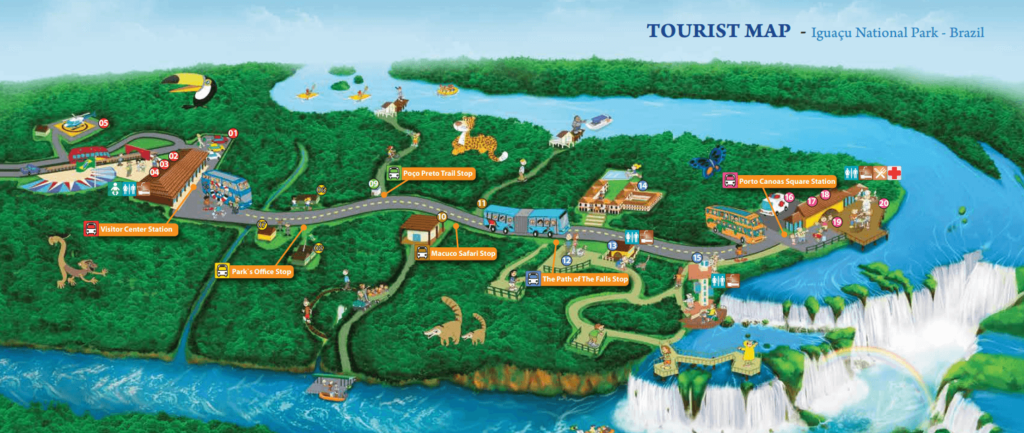
Devil’s Throat, Brazil
Stay on the bus until the final stop – the Restaurant. It is a quick 5-minute walk back to the Devil’s Throat from here. And if you came on the first bus, there is a very good chance you will have the Devil’s Throat all to yourself! The Devil’s Throat is easily the most spectacular experience on the Brazil side of Iguazu Falls.
The Devil’s Throat, or Garganta del Diablo in Spanish, is the heart of Iguazu Falls. About half of the mighty river’s flow falls down the sheer walls of the Plateau here, plunging 80 meters to the bottom of the narrow canyon with a deafening noise. And while the falls are not as tall as, say, Australia’s 268-meter Wallaman Falls, it’s the overall scale of the falls that blows your mind.
You can explore the Devil’s Throat on two levels here—at the top of the falls, which is level with the road, and at the bottom of the falls along a specially constructed walkway. However, at the lower level, you will experience the falls more than see them—as the water hits the bottom of the canyon, it creates so much spray that visibility becomes quite low, and you get completely drenched.
Tip: Bring a poncho or buy one at the gift store before jumping on the bus. The lower level platform at the Devil’s Throat is the only spot you will get wet on the trail on the Brazilian side.
Also, make sure not to wait for the scenic elevator to open. You can access the lower walkway by a set of stairs.
Back on the upper level, keep an eye out for the birds that appear to be flying right into the sheer wall of water and disappearing on the other side. They are the Great dusky swifts, and they like to nest next to waterfalls and rocky cliffs.
The Waterfall Trail
Sadly, by the time you finish exploring the Devil’s Throat, the walking trail for exploring the rest of the falls starts turning into a bit of a zoo. You can avoid some of the crowds by walking along the road instead of following the trail. But you will still have to queue up for the viewpoints.
The last lookout on the trail, opposite Belmond Hotel das Cataratas, is not as crowded, and there is a short walking trail that runs into the jungle here. We had quite a bit of luck spotting wildlife on this trail: Azara’s agouti, Capuchins and some very cool birds, including the brilliantly coloured Green-headed tanager. It is a good spot to see wild animals being wild rather than waiting for handouts along the park’s trails.
If you would like to learn more about the wildlife of Iguazu Falls, this guide will introduce you to some of the species that you are likely to encounter on your visit to the falls.
The trail runs past the remnants of an abandoned zip line attraction. The buildings at the site have been abandoned for a long time and are slowly being claimed back by the jungle. The dilapidated remnants of the zip line structure give the area a spooky Lost World feeling.
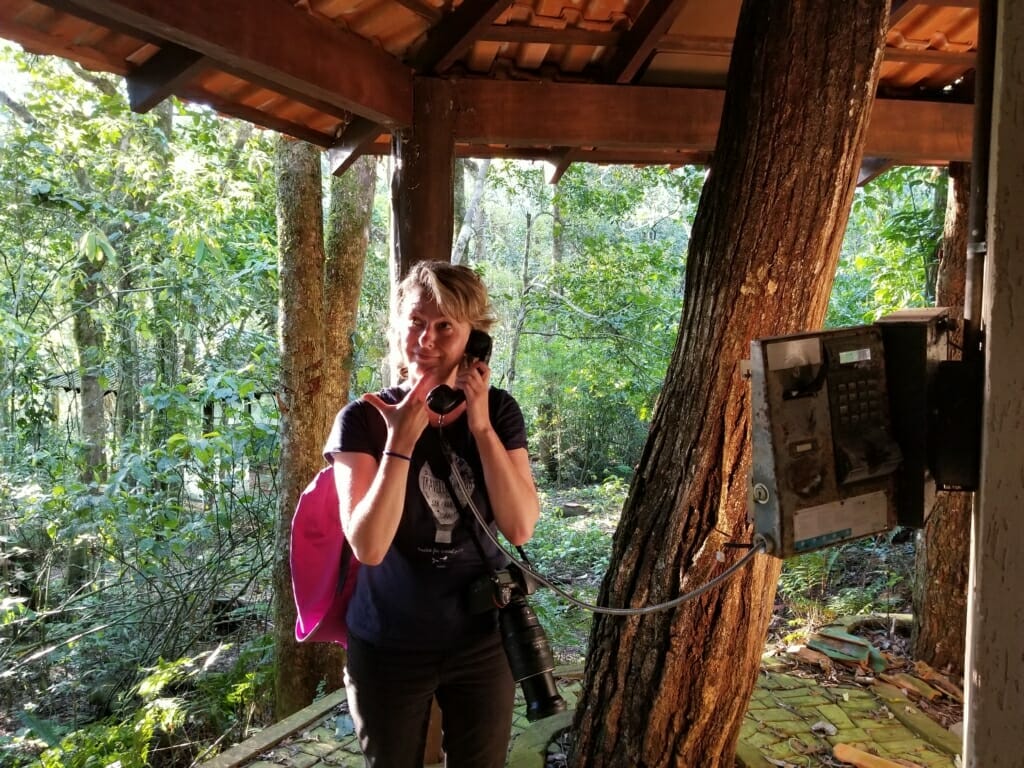
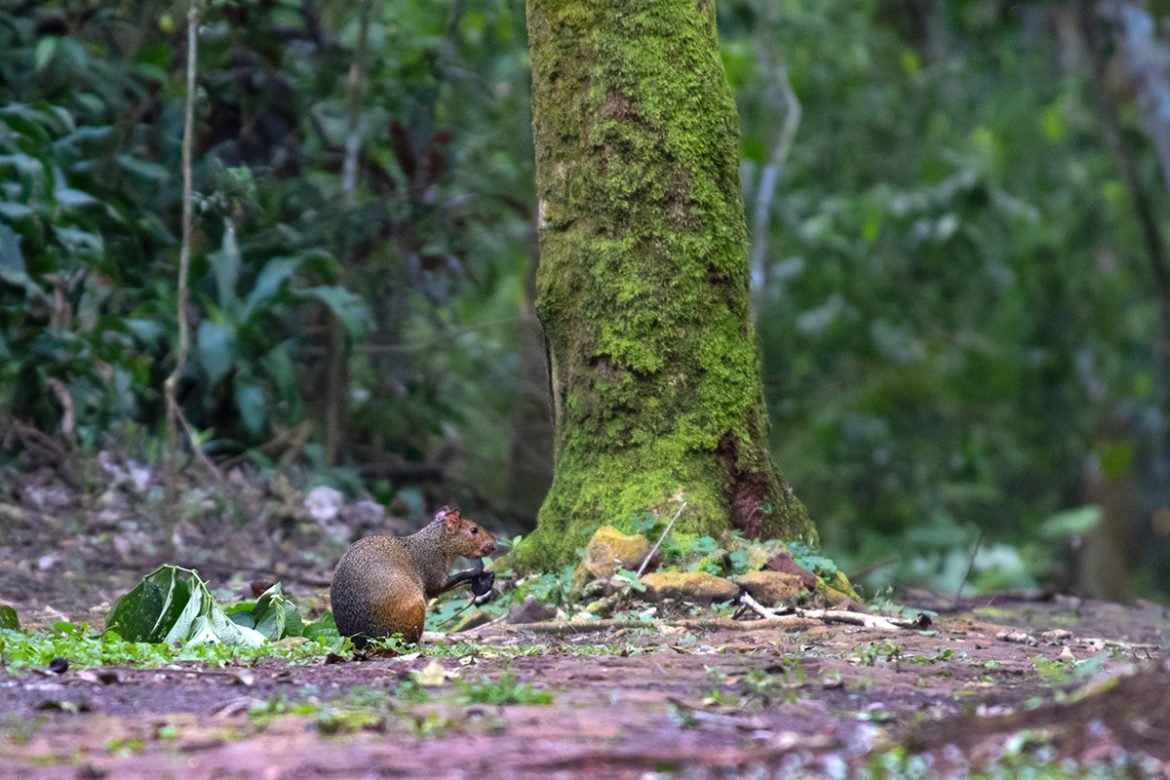
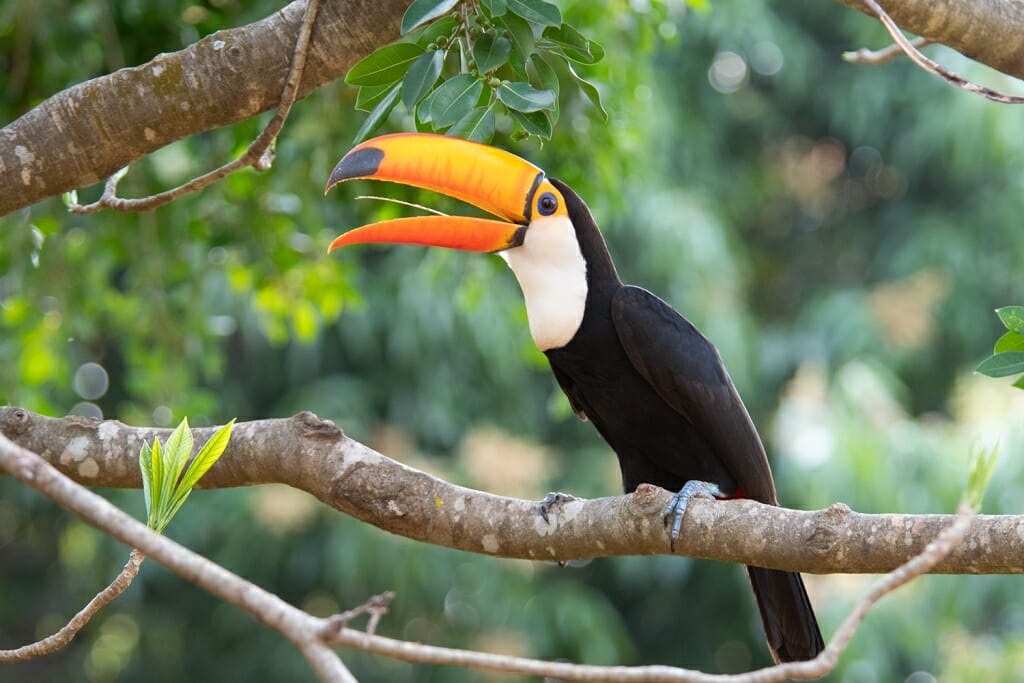
The Belmond is the only hotel located inside Parque National du Iguaçu, right across the road from the falls. So, if you feel like a splurge, spend a night at the hotel, and you will be able to have the falls to yourself by visiting outside of the park’s visiting hours.
Macuco Safari Boat ride
If there is one attraction not to be missed on the Brazilian side of the falls, it is the Macuco Safari speedboat ride (stop three on the bus). The experience starts with a bit of an unnecessary educational ride on a very slow train through the jungle. The guide provides a commentary in three languages consecutively: Portuguese, Spanish and English, and it would have been faster to walk up to the boat landing!
After the train ride, there is an optional walking safari on offer as well, though most people choose to continue to the boat ‘landing’.
Tip: Purchase your tickets online (BR$386) to avoid queueing up for them in the park
Dry boat vs Wet boat
From the ‘landing’ that contains a gift shop and lockers for your bags, you are taken down to the water’s edge, where you choose whether you want a ‘dry’ boat or ‘wet’ boat.
You will get wet on any boat, even if only from sitting in a wet seat.
The dry boat gets quite close to the falls – it actually disappears out of view behind the mist for a few seconds. So, you will still get wet unless you are happy to cover up in a poncho.
READ MORE: 50 Outstanding Safari Holidays Destinations Outside of Africa
The wet boat goes directly underneath the thundering falls, and you get a proper dunking. The force of the falls is so strong that it is almost impossible to keep your eyes open from the water hitting you from all directions. It is an absolutely exhilarating experience. The boat goes under the falls four times before riding the rapids back to the landing.
Some visitors comment that the boat operators are too intrusive, taking GoPro videos of the ride and then selling them to the passengers. We didn’t find the filming to be intrusive, and no one actually tried to sell it to us. We had to look for the counter that sold the video afterwards.
The video itself is not that great – it takes the entire boat, so you’ll end up with a dozen strangers in your clip. Unless you sit on the front seat of the boat. But you can preview the video first and decide if it is something you might like to purchase.
We took our own video of the ride with a waterproof phone
Lunch
The buffet lunch at the restaurant is absolutely worth the BR$59. After a day of baking in the blistering sun and getting drenched on the boat, the abundance of food available at the restaurant feels like heaven.
The restaurant sits on the bank of the Iguazu River, just before the river reaches the Devil’s Throat, and the view from the open-air terrace is quite spectacular. It is also a nice escape from the brazen coatis that scrape to get into your bag anywhere where food is sold.
The lawns around the restaurant and the gift shops are a good place to see the Red-rumped caciques, the medium-sized black birds with red rumps. They are abundant throughout the park, but here, you can watch them build their elaborate hanging nests in the branches of the trees.
Late Afternoon
We had our lunch quite late, about 3 pm, so by the time we emerged, the sun was moving lower in the sky, and the crowds had thinned out significantly. We took a leisurely stroll past the falls and explored the little trail near the last lookout again before catching the last bus to the park’s entrance around 4.45 pm.
The park has open wifi (you don’t need a password), so it is easy to call an Uber for the ride back.
Helicopter scenic flight
Another opportunity to splurge on the Brazilian side of the falls is to take a 10-minute helicopter flight over the falls. The flights are only operated on the Brazilian side, even though the company that offers the flights is based in Argentina. The flight costs US$335 per person for a group of 4 passengers, and unfortunately, there is no way to guarantee a window seat.
Iguazu Falls Argentina – Parque Nacional Iguazu
At a glance (visiting from Brazil)
- Time to explore: 1 day
- Closest city: Puerto Iguazú
- Opening hours: 8 am to 6 pm
- Currency: Argentinian Peso (ARS $). Credit cards are accepted everywhere in the park.
- Costs: Park entrance is $20,000 pesos.
- Perks: You can walk a number of different trails and get many different views of the falls.
Since we were based on the Brazilian side of the falls, we had to do a border crossing to visit the falls in Argentina’s province of Misiones.
To speed things up and to avoid changing and waiting for the public buses, we decided to splurge on a return taxi service which, divided between the three of us, wasn’t really that much of a splurge.
Tip: check the visa requirements for Argentina from your country. Australian and Canadian citizens are not required a visa to enter Argentina. But we did have to ensure that our Brazilian visas were multi-entry.
The driver picked us up at the hotel and took us to the immigration, where all of us cruised through the passport stamping procedure (thankfully, Australian and Canadian citizens no longer have to pay the $600 reciprocity fee to enter Argentina). Then he took us to the park entrance, arriving before the 8 am opening time.
Visiting Iguazu Falls in Argentina
If you are based on the Argentine side, make your way to Puerto Iguazu to visit the falls.
Iguazu Falls Tours on the Argentine side
If you’d rather not face the border crossing on your own, you can book tours from Puerto Iguazu to both the Argentine and Brazilian sides.
To spend the maximum amount of time exploring the falls (12 hours), consider the Gran Aventura Boat and Argentinian Falls Tour.
Or, to visit the Brazilian side from Puerto Iguazu, book the Brazilian Falls with Boat Adventure Tour.
The Parque Nacional Iguazu ticketing office opens around 8 am, so we quickly bought our tickets and lined up at the front gate.
In Argentina, instead of the buses, you are carted between the different trails on a slow train. The train is free, but unlike the Brazilian buses, you need to get a ticket, which determines which train (what time) you can ride.
Once the gate opens, it is about a 10-minute walk to the train, and it gets a little chaotic with the tour guides rushing ahead to get spots at the front of the line for their groups.
The train has only three stops:
- Central at the park’s entrance
- Cataratas for both the Upper and Lower Circuits
- Devil’s Throat
Devil’s Throat, Argentina Side
The first train leaves for the Devil’s Throat at 8.30 am and then every 15 minutes. Encouraged by our tranquil morning experience on the Brazilian side, we decided to start at the Devil’s Throat again (the last train stop). Though in hindsight, we should’ve left it until the late afternoon (more on this later).
On the Argentinian side, Devil’s Throat is trickier to access than in Brazil because it lies on the other side of the Iguazu River, which, at this point, is about a kilometre wide. To make the river crossing possible, an elevated wooden walkway has been constructed that leads all the way to the drop.
Tip: You will need your poncho again at the Devil’s Throat.
Very much unlike the Brazilian side, there are no quiet periods here. Even if you arrive on the first train, you’ll be sharing the experience with about a hundred people. And at 9 am the sun is in your face, which makes photography very difficult.
But nonetheless, the sight of millions of litres of water plunging down vertical cliffs underneath your feet is awe-inspiring. The water falls with so much force that every few minutes large clouds of spray shoot into the air and empty onto the viewing platform.
There is only one way to view Devil’s Throat on the Argentina side – from the very top of the falls.
The Upper Circuit
The best part about the Argentine side of the falls is the extensive walking trails, divided into the Upper and Lower Circuits. And since there are so many trails here, the crowds are dispersed among them, and the experience of viewing the falls is nowhere near as chaotic as on the Brazilian side. The trails are probably the best part of Argentina side of Iguazu Falls.
The Upper Circuit of the falls is the most paradisiacal area in the park. I was often reminded of the Lord of the Rings scenery as the veils of the falls came into view along the trail. Depending on how much you linger, you could complete the circuit in 1 hour or spend half a day exploring the different viewpoints.
The Lower Circuit
The Lower Circuit is much steeper, and you get to feel the spray of the falls again at some of the viewpoints.
The two circuits are where you are most likely to come face to face with the park’s less shy wildlife. Coatis and Capuchins boldly sit by the sides of the trails waiting for handouts. Please resist the urge to feed them and keep in mind that both species have a nasty bite.
Macuco Trail
If you have enough time left and feel like you’ve had just about as many crowds as you can handle, spend an hour walking the Macuco trail. This is your chance to explore another part of one of the most scenic national parks in Argentina. The entire trail is quite long, but you can walk as much of it as you like or have time for.
Lunch
There are two food courts: at the Cataratas train station and at the start of the Lower Circuit. Fortin Cataratas Restaurant is a good option for a buffet lunch in a coati-free environment.
Late Afternoon
Late in the afternoon, we decided to return to the Devil’s Throat, and with the sun behind our backs, it was a much more picturesque experience than our morning visit.
As agreed, the driver was waiting for us at the front just as the park closed.
Full moon walk
If you are visiting during the full moon you can visit the park after dark to see the Devil’s Throat under the light of the full moon. There are three departures for the walk each night, but the times vary, so you’ll need to check the website for the walking times during your dates. The cost is 16,500 pesos per person and includes dinner.
You will need to make your own way back to your hotel. Alternatively, you can splurge and stay at the Gran Melia Iguazu (formerly the Sheraton) – the only hotel within the National Park.
I hope you found this guide to visiting Iguazu Falls useful and inspiring. If you visited the falls recently, share your tips and updates in the comments.
More Nature Adventures in Brazil & Argentina
- A Practical Guide to Visiting Iguazu Falls in Brazil & Argentina
- Where to See Peninsula Valdes Orcas and Other Patagonian Wildlife
- Watching wild jaguars in the Pantanal, Brazil
- 35 Amazing Brazilian Animals and Best Places to See Wildlife in Brazil
- On the trail of the ocelot in Brazil
- 11 Stunning South American Wild Cats and Where to See Them
- Top 10 Pantanal Adventures For Your Brazil Holidays
- Brazil Itinerary: watching wildlife in Brazil without breaking the budget
- 7 Fun things to do in Paraty, Brazil
- Maned wolves and Catholic monks of Santuario do Caraça

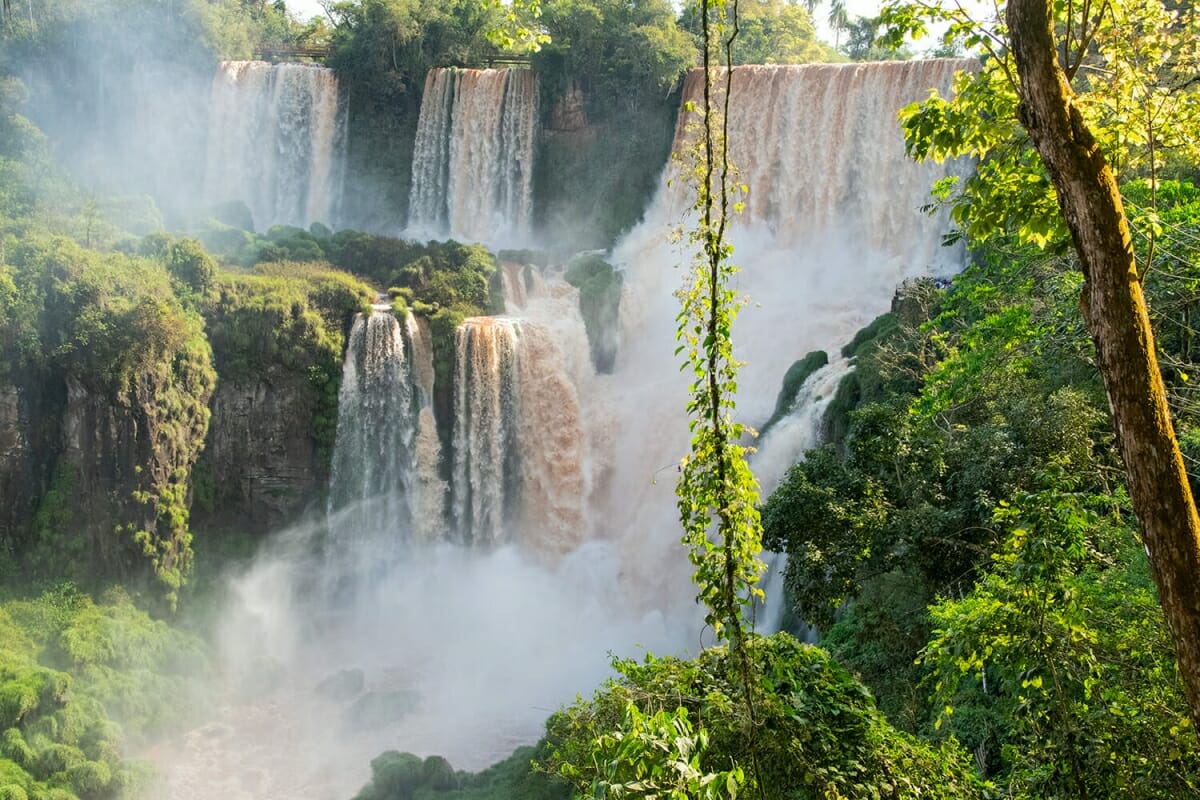

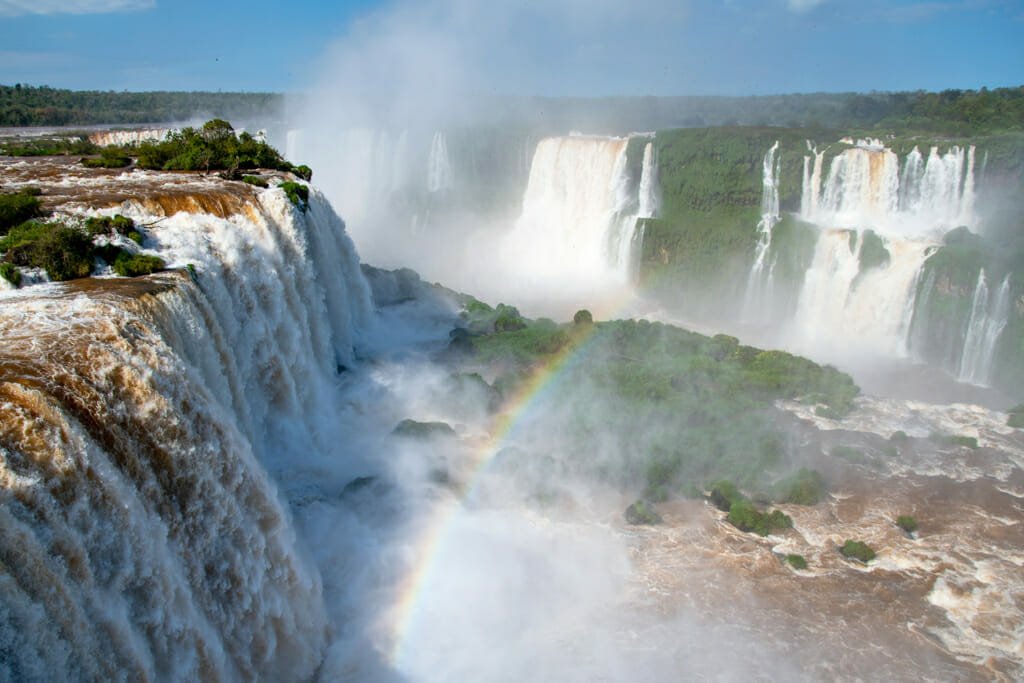
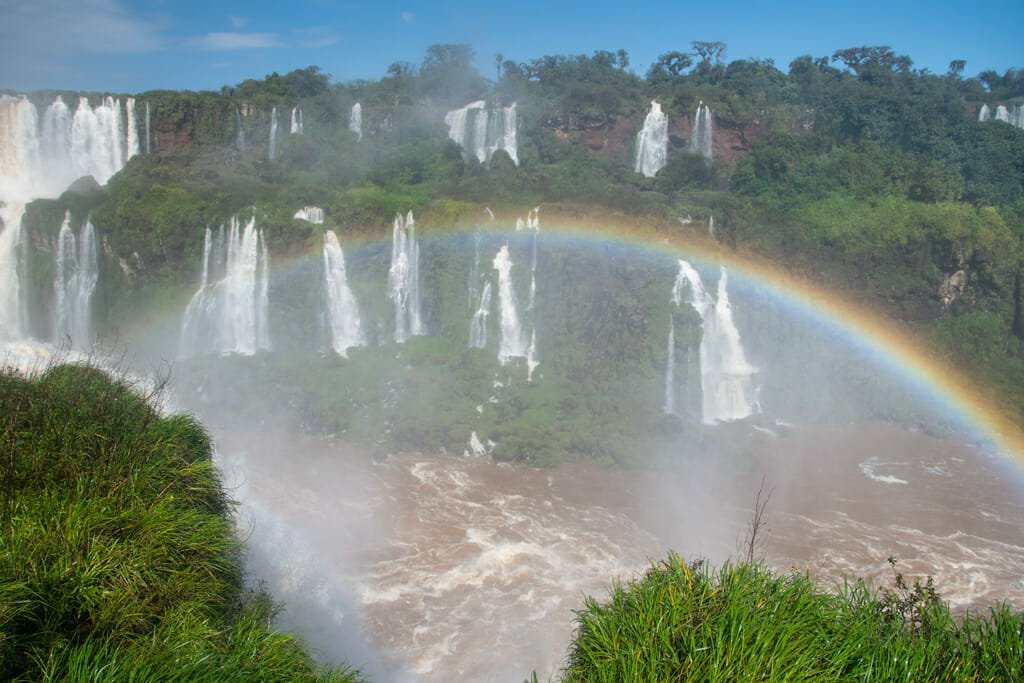
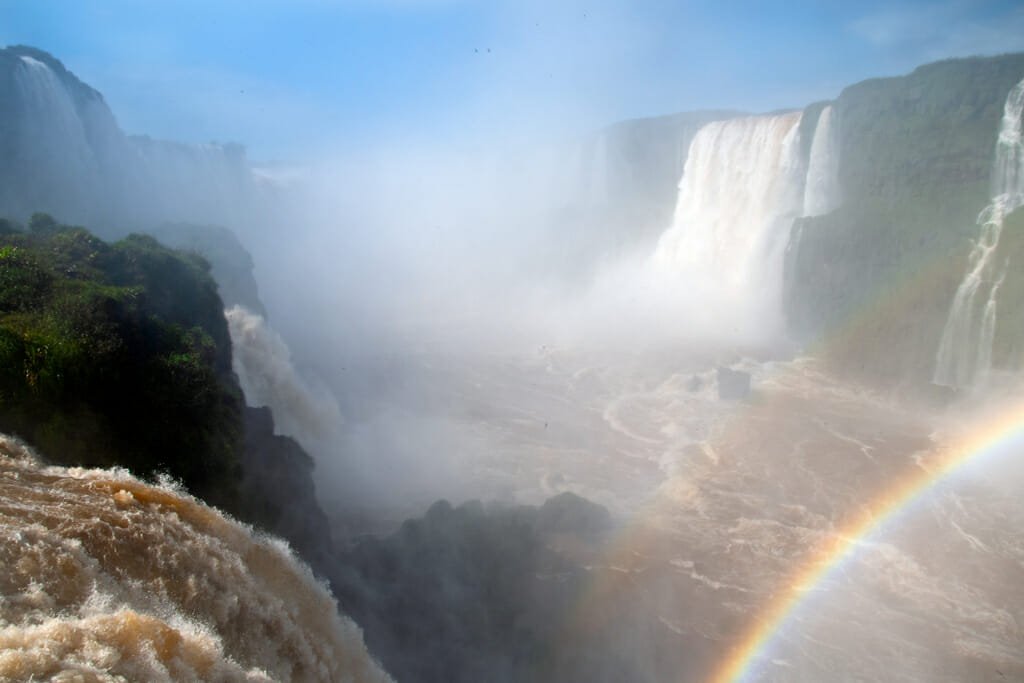
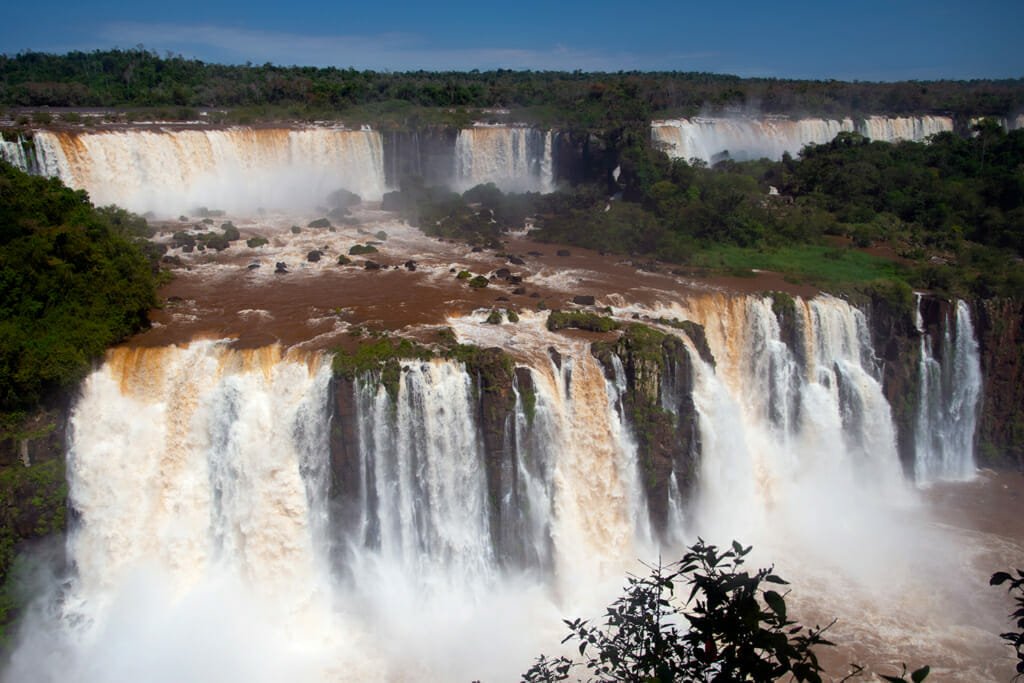
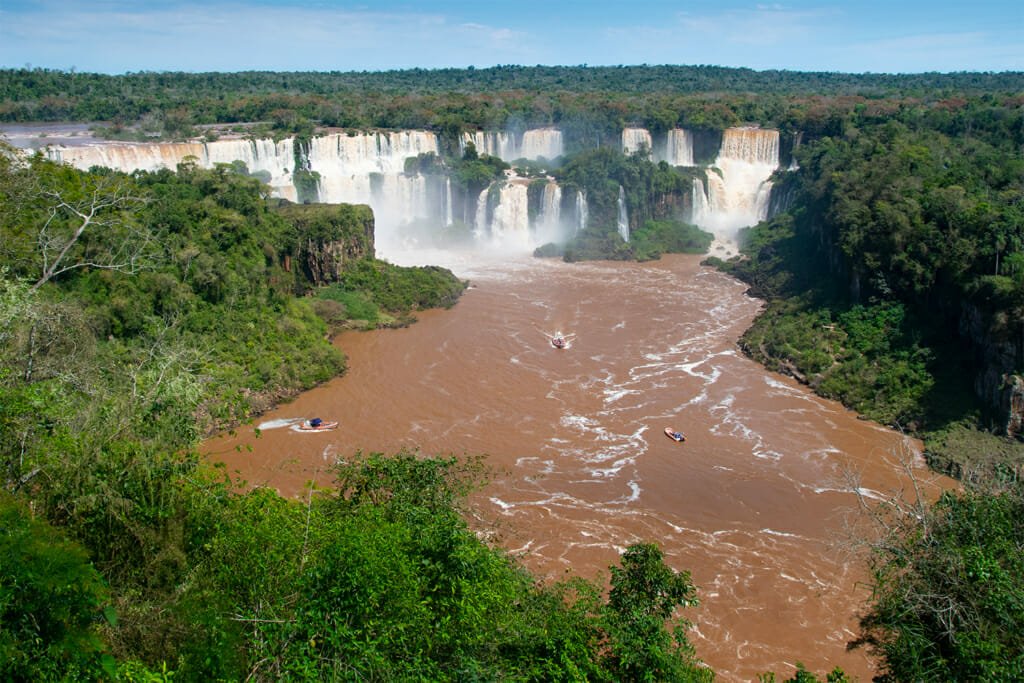
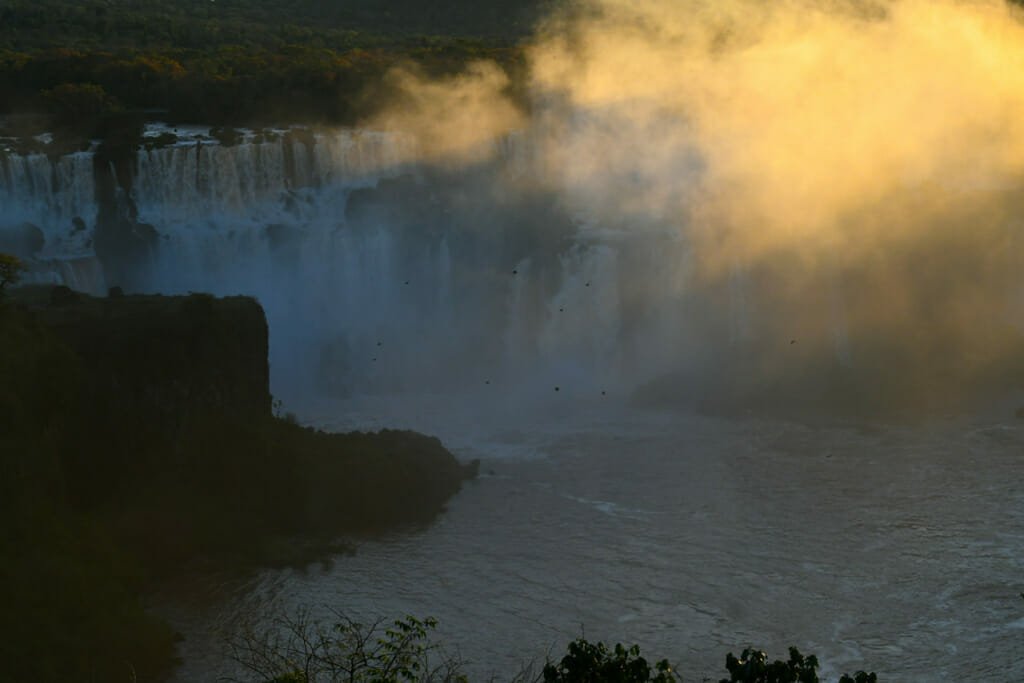
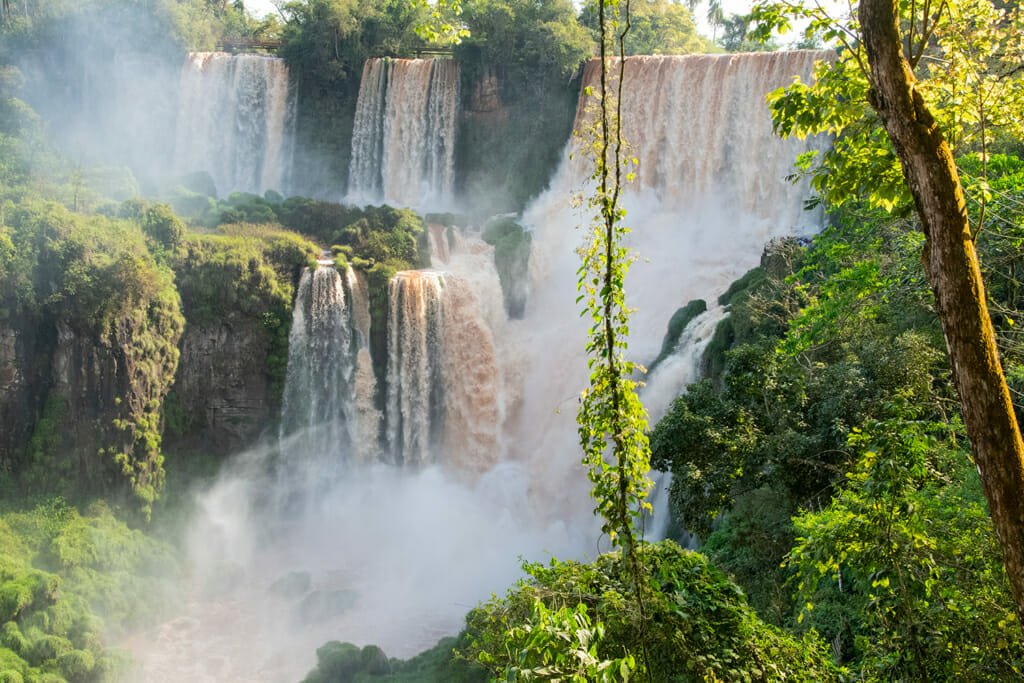
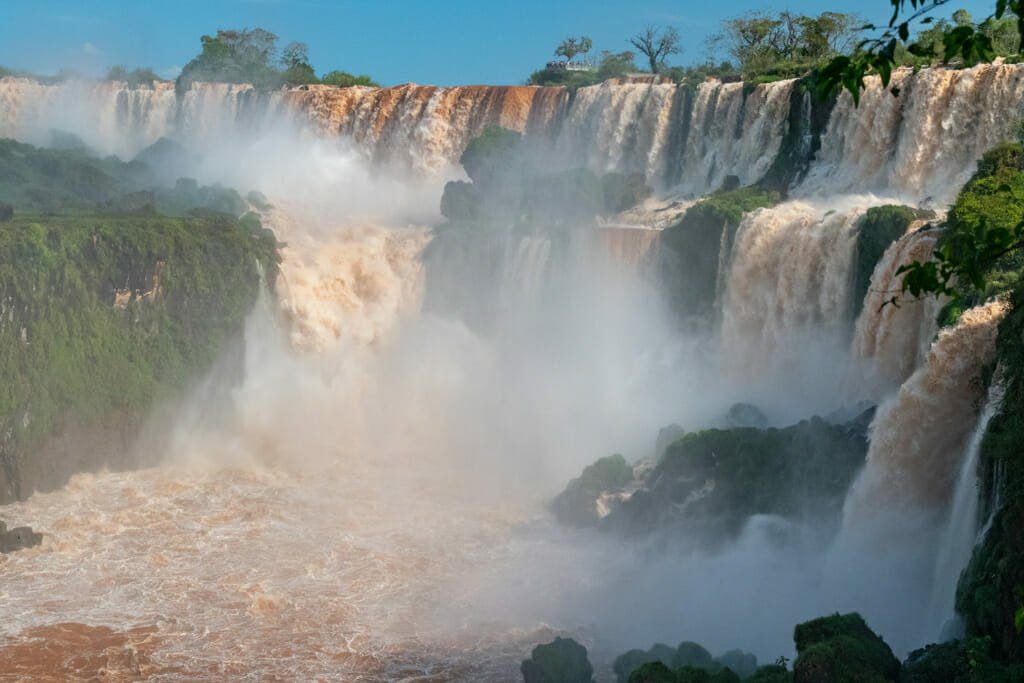
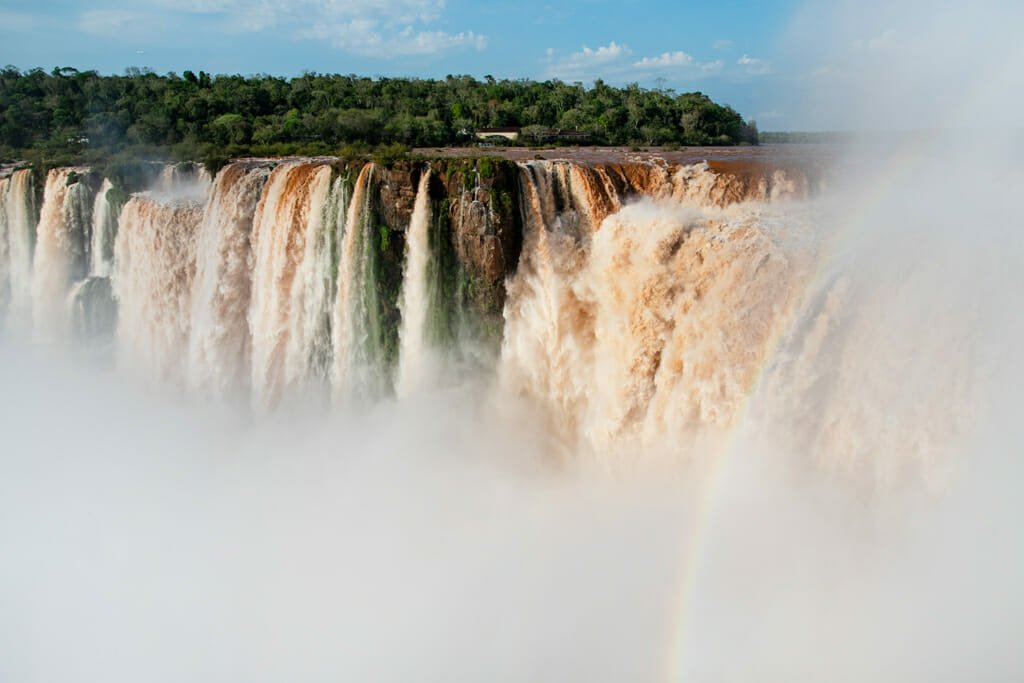
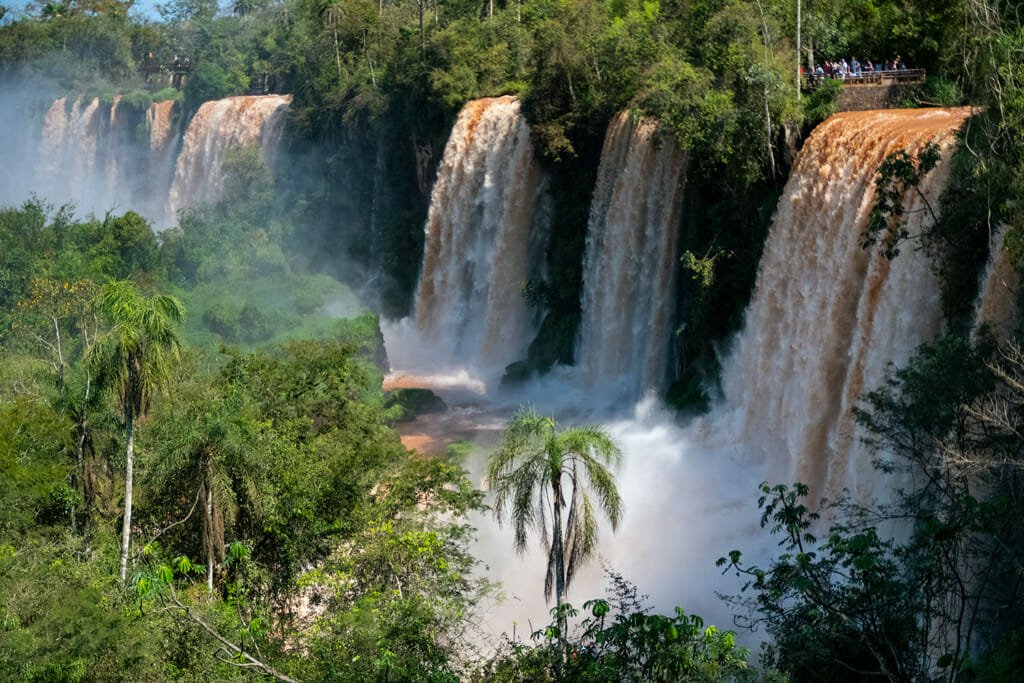
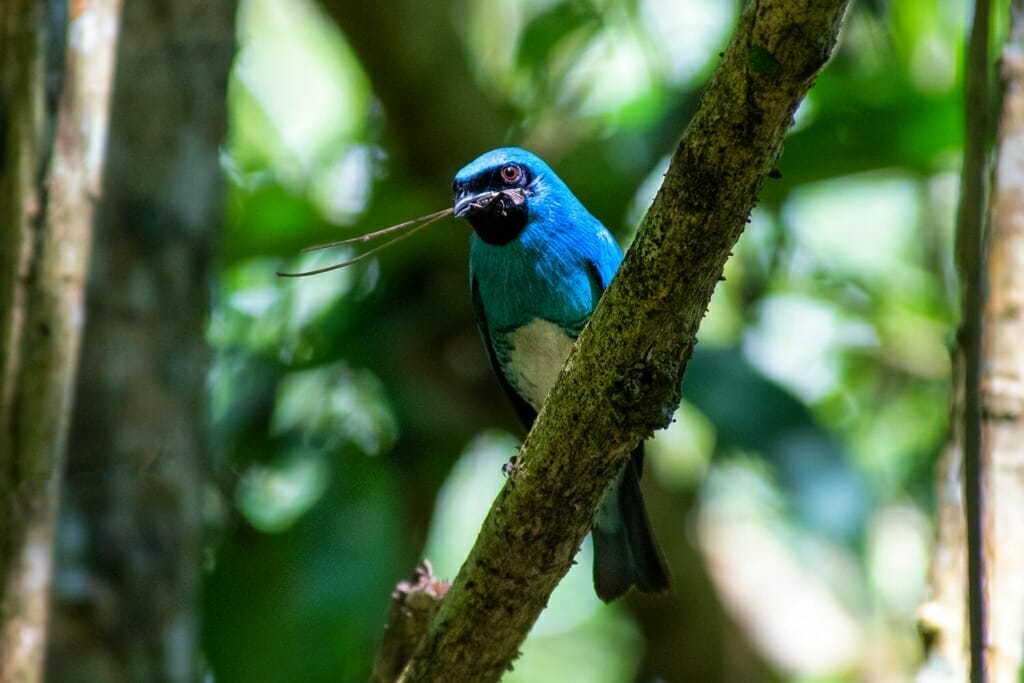
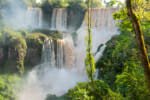







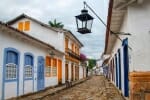
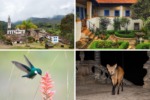
Great post and fantastic photos, the falls look amazing. We hope to visit both sides of the falls during our tour of Brazil. Thank you for sharing so much useful and interesting information 😁
Thank you for dropping by and for your kind words Michaela & Phil. Best wishes for your trip to Iguazu Falls!
What a fantastic post! I have to admit that images never do waterfalls justice, but yours are magnificent. I also enjoy the animals and I have already visited this location.
Hi Margarita
My son and I are visiting the falls soon, and were wondering about the different ways to do the border crossing. Can it be done via public buses? Is Uber easy to get on both sides? What if we rented a car? Can you assist with any of these questions? Thanks!
Ray
Hi Ray, I would suggest getting advice from a travel agent to be on the safe side. Generally, yes, it can be done via public busses though it is a long process as you have to change busses. Uber may not be able to get you across the border. But you can organize a taxi service (via your accommodation provider) who do these border crossings regularly. This is what we did. The driver took us across the border from the Brazilian side in the morning and then collected us on the Argentine side at the end of the day and took us back across the border. Hope this helps. Cheers, Margarita
Hi Margarita, what a nice post! Thanks for all the info!
We will be lucky to get there on a full moon day, so, I would try the night tour on the Argentinian side, but we are going to stay on the Brazilian side, how can we get back to Brazil so late after the tour? Maybe a taxi? How long will it take? We have a 5 y.o. boy with us, is the night tour recommended with a child? One more question, we will land on the Brazilian airport at 1PM, too late to go visiting the waterfalls in winter directly from the airport? Thanks!!!
Hi Emanuele,
How are you getting to the Argentine side in the morning? The easiest option for the return after the night tour is to book a return taxi from the Brazilian side. Your hotel should be able to organize it. It should cost around BR$250 for the return trip. And you would organize the pick-up time in Argentina directly with the driver. Otherwise, it might be difficult to find a taxi in Argentina late in the evening. From memory, the trip takes about 40 min.
In regards to visiting the falls from the airport at Foz du Iguacu, it will be quite tight, if you land at 1 pm. The taxi or an Uber to the park will take about 20-30 min. Once in the park, take the free shuttle to the top and start at the Devil’s Throat. If you are there by, say 2 pm, you’ll have just over 2.5 hrs to explore the falls. The last bus from the falls back to the visitor center leaves around 4.45pm. Trouble is, the trail from the Devil’s Throat to the other lookouts gets very busy, and the foot traffic moves slowly. The trail is not very long, though. So if you explore the Devil’s Throat first, you could continue down the trail and cover as much of it as you can before the last bus.
The trail runs parallel the road, so just make sure to be at one of the bus stops by 4.30 pm or so. And there is free WiFi at the visitor center, so you can book an Uber for the ride back to town.
Cheers,
Margarita
Great page! We are going to be there in July. We arrive on the Argentinian side (~ 3pm on day 1) and leave from Brazil (~noon on day 4), so we have 2 full days. How would you recommend that we spend our time? Maybe visit the Arg side on day 2, then go to Brazil; visit the Braz side on day 3? We are thinking of spending 1 night at the Belmond, in the park. Also, someone I know recommended a visit to the dam itself, did you go there?
Hi Judy,
Two days at Iguazu sounds perfect. 1 day on Argentine side, 1 day on the Brazilian side. It will be a full day on Argentine side, there is a lot to see and the walking trails are much longer. The best things about Brazilian side is that you get really close to the falls at Devil’s Throat and get panoramic views of the Argentine side from the trail.
If you are changing hotels in the morning, you may miss the chance to be the first people at the Devil’s Throat in Brazil, when you can have the falls to yourself for a few minutes. But if you stay at Belmond, you’ll have the perfect opportunity to wander to Devil’s Throat in the morning of day 4 before the park opens to visitors. And even more amazingly, you will have the entire trail to yourself! In hind site, I would have definitely splurged on Belmond. So you can take it easy on day 3, take the boat ride, have long lunch at the restaurant on the riverbank and visit a couple of viewpoints. The trail between the Devil’s Throat and Belmond is not that long, so you’ll have plenty of time to walk it in the morning before your departure.
We haven’t been to the dam since we only had 2 full days at Iguazu as well, so we spent the daylight hours exploring the falls themselves.
Hi Margarita! I’m back home after my trip. We feel like we had the perfect Iguacu experience! On day 1, after we arrived on the Argentina side, we had time to do the Upper Circuit trail. On day 2 we did the boat trip (that was FUN!), the Lower Circuit, and the Devil’s Throat at the end of the day (excellent suggestion of yours!). On day 3 we traveled to Brazil by taxi and visited that side. Based largely on your comment above (“In hind site, I would have definitely splurged on Belmond”) we did book the Belmond – a splurge, but worth it! The Brazilian side was very busy, but this way we got to hang out late, when it was much quieter, even after the park rangers were telling people to leave. We also went over to see the lower falls, across the street from the hotel, around 11 pm. On day 4 we got up very early, and we were at the Devil’s Throat walkway before sunrise. We had it all to ourselves!
Looking back, I think that the Argentina side has more to do, but the Brazil side has the most impressive views. For that reason, I would recommend doing Argentina first.
Thanks for your very informative blog (and well-written, too!). Your detailed suggestions are very good, and I would recommend them to everyone!
Oh, just one thing – I think they don’t require a ticket to the train on the Argentina side anymore. We asked a ranger where to buy it, and he shrugged it off and told us to board the train.
This sounds like a fantastic trip to the falls, Judy! Now I wish even more that we stayed at Belmond. Sunrise over the falls with no one else around would’ve been a jaw-dropping experience. As would be a nighttime visit to the falls. If I head back to the falls, I will definitely stay at Belmond! I am so glad you found the suggestions in the post useful. I completely agree Argentine side offers opportunities for exploring while Brazil has better views. Plus the Devil’s Throat at Brazil is a much more up-close-and-personal experience.
Good to know they are not bothering with the train tickets in Argentina anymore. It was such a nuisance and created unnecessary queues and delays.
Your post is very very good, having seen many poor ones. All info is here. Apart from nice photos. Congrats, really. I will be there next November, been before but long ago.
Thank you, Algirdas. I tried to include everything I wanted to know when I was planning my own trip. Plus the things I didn’t know that I would want to know :). And I wanted to go back ever since I left :).
Great post! Iguazu Falls are truly incredible, one of the most amazing places I’ve visited so far.
So envy that you get a chance to spot some toco-toucans in the wild! I’ve been there last year in August and the only ones we saw were in the Brazilian Parque des Aves :(
I found it quite tough to spot wildlife at Iguazu too. It’s so hard to tear yourself away from the falls, that you hardly notice anything around you. Apart from the critters that try to get into your bag looking for scraps :)
This looks mind-blowing! Thanks for writing and sharing such a detailed article, it’s actually covered EVERYTHING that I needed to know. The wildlife looks awesome and can certainly agree that it has a Lost World feel to it. So excited after reading this, thank you so much for all the information…..now to book a flight ;)
Thank you, Becki! I’m glad the guide is useful. We were lucky to meet a couple of people along the way who shared their tips with us. And these were some of the best pointers.
I can’t believe I missed Iguazu Falls when I was in Brazil earlier this year – it looks absolutely spectacular! Cool to see the array of wildlife too, I have never heard of the coati but it looks super cute!
Lol, coatis are adorable. Though at the falls, you mostly meet the habituated ones – they are brazen and can be dangerous. But it’s nice to see some of them browsing on the forest floor rather than in the restaurant rubbish bins.
What an amazing post! I have to say that photos never do justice to the grandeur of waterfalls but yours are fantastic. Love the wildlife too – hope I’ll be able to visit someday.
Thank you, Brooke. You are so right, there is no way to capture the magnitude of Iguazu Falls. They are larger than life